A History of Football Kit Design in England and Scotland
(5) Post War Austerity and Boom 1945-1960
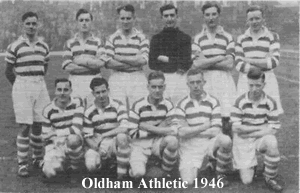 In the immediate aftermath of the war the United Kingdom was on the verge of bankruptcy and faced massive costs for reconstruction and to implement the new Labour government's extensive social welfare reforms. Wartime rationing of food and clothing continued into the next decade. The rationing of clothing applied to football clubs as well as the general public and several teams that wore non-standard jerseys turned out in unfamiliar tops because their usual jerseys were not available.
In the immediate aftermath of the war the United Kingdom was on the verge of bankruptcy and faced massive costs for reconstruction and to implement the new Labour government's extensive social welfare reforms. Wartime rationing of food and clothing continued into the next decade. The rationing of clothing applied to football clubs as well as the general public and several teams that wore non-standard jerseys turned out in unfamiliar tops because their usual jerseys were not available.
Oldham Athletic, for example, borrowed a set of red and white hooped shirts from their neighbouring rugby league club, Oldham RLFC in 1946. It was not until 1948 that they were able to revert to their familiar blue and white shirts. Humble Southport, who normally wore black and white stripes, played in green and white between 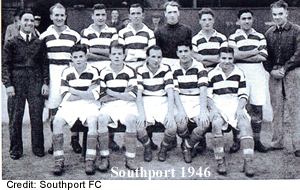 1944 and 1948, a gift from one of their directors.
1944 and 1948, a gift from one of their directors.
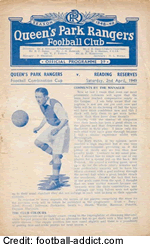 After winning promotion to Division Two in 1948, Queen's Park Rangers appealed for donations of spare clothing coupons so they could replace their worn out kit. Unfortunately their distinctive broad hoops were not available so instead the team wore blue shirts with white sleeves. In March 1949 the directors got hold of a set of sample shirts in Ranger's traditional pattern and put them on display alongside their current top at a reserve game. The 7,000 supporters present at the match were asked to cheer for their favourite. The broad hoops were reinstated the following season but the generosity of the supporters did not end there. In 1950 the directors offered free wool and knitting needles to anyone prepared to darn the team's worn out socks. Hearing of this the redoubtable Miss Gertrude Parker, aged 80, set about knitting with a will and after getting through 12lbs (5.44kg) of yarn, Gertie presented the club with
After winning promotion to Division Two in 1948, Queen's Park Rangers appealed for donations of spare clothing coupons so they could replace their worn out kit. Unfortunately their distinctive broad hoops were not available so instead the team wore blue shirts with white sleeves. In March 1949 the directors got hold of a set of sample shirts in Ranger's traditional pattern and put them on display alongside their current top at a reserve game. The 7,000 supporters present at the match were asked to cheer for their favourite. The broad hoops were reinstated the following season but the generosity of the supporters did not end there. In 1950 the directors offered free wool and knitting needles to anyone prepared to darn the team's worn out socks. Hearing of this the redoubtable Miss Gertrude Parker, aged 80, set about knitting with a will and after getting through 12lbs (5.44kg) of yarn, Gertie presented the club with 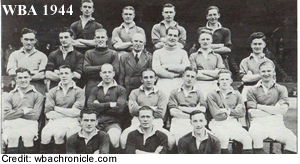 24 pairs of pristine blue and white socks.
24 pairs of pristine blue and white socks.
Another club affected by the shortage of football shirts was West Bromwich Albion who were unable to get hold of their traditional navy and white shirts during the war and instead played in royal blue shirts until 1947.
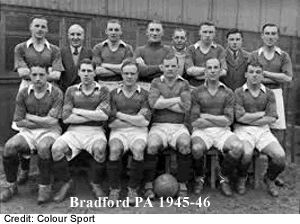 The shabby, faded appearance of Bradford PA's jerseys worn in the 1945-46 season suggest that they had nursed these red, amber and black tops through the entire war.
The shabby, faded appearance of Bradford PA's jerseys worn in the 1945-46 season suggest that they had nursed these red, amber and black tops through the entire war.
Numbered shirts had been introduced in the Football League in 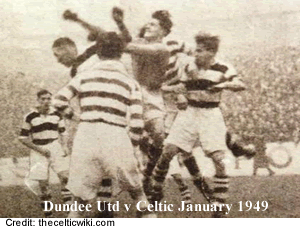 1939 and now appeared in the Scottish Football League, when it resumed in 1946. Curiously, however, numbers were not compulsory there and Celtic refused to wear them until 1960 when, thanks to the idiosyncratic views of their chairman, Bob Kelly, they were applied to the front and back of the players' shorts rather than sully the back of their shirts.
1939 and now appeared in the Scottish Football League, when it resumed in 1946. Curiously, however, numbers were not compulsory there and Celtic refused to wear them until 1960 when, thanks to the idiosyncratic views of their chairman, Bob Kelly, they were applied to the front and back of the players' shorts rather than sully the back of their shirts.
Attendances at football matches were at an all-time high in the years after the war. The rationing of clothing ended in March 1949 but food remained on the ration until July 1954.
In 1953 Bolton Wanderers met Blackpool in the legendary Stanley Matthews FA Cup Final in a
kit 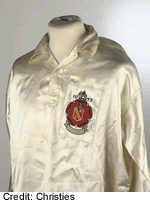 specially produced by Umbro for the occasion. This was almost certainly made from rayon but it had a quite different appearance to
specially produced by Umbro for the occasion. This was almost certainly made from rayon but it had a quite different appearance to 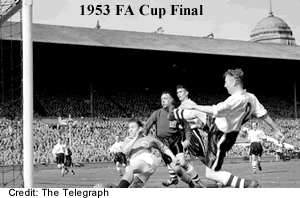 the West Brom shirt that was worn in the 1935 final. The material had a shiny finish which became de rigeur for finalists over the next few seasons. Preston (1954) and Birmingham City (1956) wore similar kit.
the West Brom shirt that was worn in the 1935 final. The material had a shiny finish which became de rigeur for finalists over the next few seasons. Preston (1954) and Birmingham City (1956) wore similar kit.
In point of fact, these novel outfits had been introduced a couple of years earlier. The first recorded example dates from a gloomy afternoon in November 1951 when Wolverhampton Wanderers wore experimental irridescent yellow shirts in the second half of their game against Charlton Athletic. They were used again a month later and when floodlights were installed at Molyneux in 1953, the shiny shirts were again worn as they showed up far better 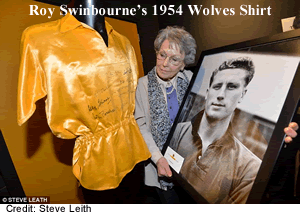 than Wolves' usual old gold tops. Notably they were worn when Wolves beat the Hungarian champions, Honved, under lights in December 1954, a match that was televised live by the BBC.
than Wolves' usual old gold tops. Notably they were worn when Wolves beat the Hungarian champions, Honved, under lights in December 1954, a match that was televised live by the BBC.
Spurs, Newcastle United and Sunderland all experimented with shirts made from this novel material when they installed floodlights of their own and a number of other clubs adopted this novel fabric. When Torquay United's board of directors decided to refresh the image of their team with bright gold shirts and blue sleeves to represent the sand of sea of the resort, rayon was the fabric of choice.
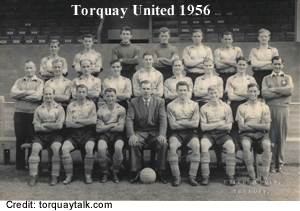 The floodlit friendlies against top European teams whetted the public's appetite for international club matches and over the rest of the decade, with Hibernian and Manchester United leading the way, clubs began to participate in European competition despite
the initial hostility of the FA and SFA. Austerity was over and the economy began to boom while live broadcasts of matches on the BBC was bringing the game to a wider audience than ever.
The floodlit friendlies against top European teams whetted the public's appetite for international club matches and over the rest of the decade, with Hibernian and Manchester United leading the way, clubs began to participate in European competition despite
the initial hostility of the FA and SFA. Austerity was over and the economy began to boom while live broadcasts of matches on the BBC was bringing the game to a wider audience than ever.
England’s 3-6 humiliation at Wembley by Hungary in November 1953 led to a dawning realisation that
British football was perhaps not as superior as it had always been supposed. The 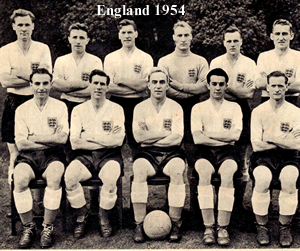 debacle may not have persuaded the English FA to review their antiquated approach to team selection and tactics but it did inspire Umbro to produce a new, streamlined kit which was first worn by the England team in November 1954. The "Continental" style, as it was called, featured sleek V necks instead of cumbersome collars, short
debacle may not have persuaded the English FA to review their antiquated approach to team selection and tactics but it did inspire Umbro to produce a new, streamlined kit which was first worn by the England team in November 1954. The "Continental" style, as it was called, featured sleek V necks instead of cumbersome collars, short 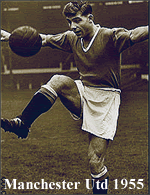 sleeves and lightweight, cotton shorts cut much shorter than those traditionally worn in the UK (many European sides had been wearing light weight shorts since before the war). Nylon socks replaced the chunky woollen ones that had been worn since time immemorial.
sleeves and lightweight, cotton shorts cut much shorter than those traditionally worn in the UK (many European sides had been wearing light weight shorts since before the war). Nylon socks replaced the chunky woollen ones that had been worn since time immemorial.
These modern-looking strips caught on quickly with clubs and by 1957 almost every team in England and Scotland was wearing the new-look outfits although the older, long-sleeved shirts were often retained for use in cold weather, particularly in Scotland.
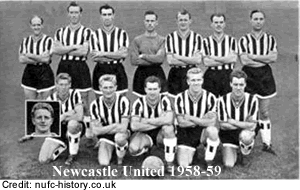 Newcastle United, who had won the FA Cup three times earlier in the decade embraced the new style with enthusiasm, adding various grace notes such as lined trim at the V neck and cuffs, contrasting hems on the shorts and vertical stripes on the sock turnover. At the time these were regarded as cutting edge but it is remarkable how quickly such things begin to look dated.
Newcastle United, who had won the FA Cup three times earlier in the decade embraced the new style with enthusiasm, adding various grace notes such as lined trim at the V neck and cuffs, contrasting hems on the shorts and vertical stripes on the sock turnover. At the time these were regarded as cutting edge but it is remarkable how quickly such things begin to look dated.
The majority of clubs were content to update their traditional designs to the Continental style without gratuitous additional detailing. Oldham Athletic, for example, stuck with their signature blue and white shirts, but now with V necks and short sleeves. 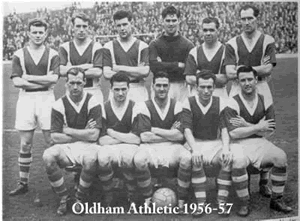 Curiously, Oldham's shirts were always described in the various handbooks that were published each summer as "blue and white." This may be because a proper description would have required too much space.
Curiously, Oldham's shirts were always described in the various handbooks that were published each summer as "blue and white." This may be because a proper description would have required too much space.
The introduction of the Continental design seems to have coincided with or perhaps prompted a more fashion conscious attitude among clubs. Britain's economy was booming and there was a desire to grasp modernity and leave the misery of war and austerity behind.
The 1956 FA Cup final between Manchester City and Birmingham City was the stage for Umbro to launch a smart new design. Because of a colour clash both 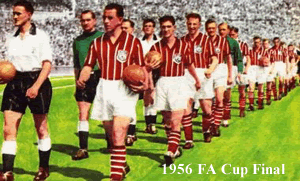 teams had to change: Birmingham took the field in shiny off-white "silk" shirts while City wore striking maroon shirts with white candy-stripes. History repeated itself with City winning the cup as they had in 1934 when they also wore maroon and white.
teams had to change: Birmingham took the field in shiny off-white "silk" shirts while City wore striking maroon shirts with white candy-stripes. History repeated itself with City winning the cup as they had in 1934 when they also wore maroon and white.
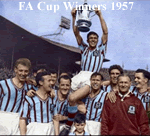 A year later it was the turn of Aston Villa and Manchester United to contest the final and once again both sides had to change. This time round it was Bukta who supplied Villa with the latest candy stripes in their traditional claret and blue colours.
A year later it was the turn of Aston Villa and Manchester United to contest the final and once again both sides had to change. This time round it was Bukta who supplied Villa with the latest candy stripes in their traditional claret and blue colours.
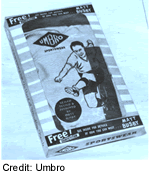 Live broadcasts of both matches provided all the publicity Umbro and Bukta could wish for and very quickly clubs from all over the UK were placing orders for the new style.
Live broadcasts of both matches provided all the publicity Umbro and Bukta could wish for and very quickly clubs from all over the UK were placing orders for the new style.
In 1959 Umbro launched the "Umbroset" endorsed by Matt Busby. These were child-size replica kits that came individually packaged in an illustrated presentation box. Endorsement by a prominent football figure suggested authenticity but the focus shifted onto young players and a "wear the shirt, play like your hero" marketing strategy when the young Denis Law attached his name and likeness to the product in 1964. The Umbrosets were the first replica kits to be aimed at children and their parents individually rather than organised youth teams and as such may be considered to mark the birth of the replica kit market.
© Dave Moor (2023)